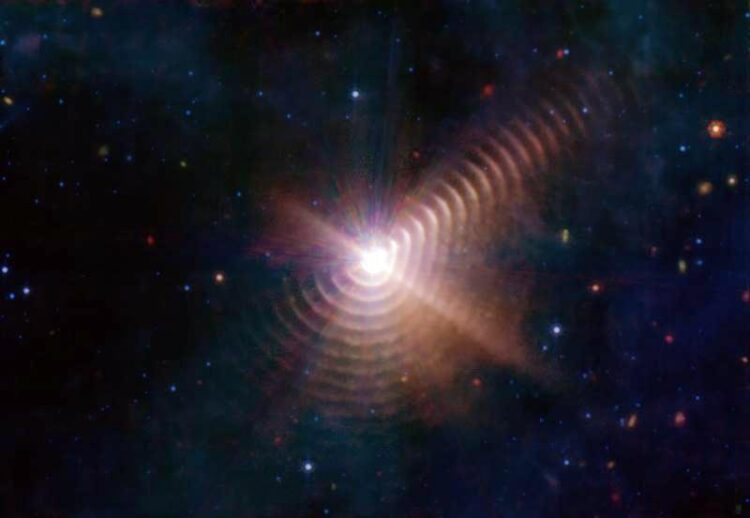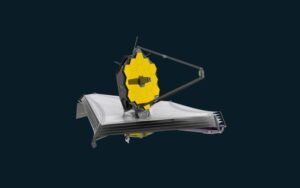A ‘Fingerprint’ in Space

The two stars in Wolf-Rayet 140 produce shells of dust every eight years looking like rings, as seen in this image from JWST. Each ring was created when the stars came close together and their stellar winds collided, compressing the gas and forming dust.
Credit: NASA, ESA, CSA, STScI, JPL-Caltech
A new image obtained with the James Webb Space Telescope reveals a remarkable cosmic sight: at least 17 concentric dust rings emanating from a pair of stars. Located just over 5,000 light years from Earth, this stellar duo is collectively known as Wolf-Rayet 140. The research team led by US astronomer Ryan Lau includes Gerd Weigelt from the Max Planck Institute for Radio Astronomy in Bonn, Germany.

Credit: ESA/ATG medialab
A new image from the James Webb Space Telescope (JWST) reveals a remarkable cosmic sight: at least 17 concentric dust rings emanating from a pair of stars. Located just over 5,000 light years from Earth in the constellation Cygnus (the swan), the duo is collectively known as Wolf-Rayet 140 (WR 140). Each ring was created when the two stars came close together and their stellar winds (streams of gas they blow into space) collided, compressing the gas and forming dust. The stars’ orbits bring them together about once every eight years; like the rings of a tree’s trunk, the dust loops mark the passage of time.
“We’re looking at over a century of dust production from this system,” said Ryan Lau, an astronomer at NSF’s NOIRLab and lead author on a new study about the system, published today in the journal Nature Astronomy. “The image also illustrates just how sensitive JWST is. Before, we were only able to see two dust rings, using ground-based telescopes. Now we see at least 17 of them.”
In addition to the overall sensitivity of the JWST, the Mid-Infrared Instrument (MIRI) is uniquely qualified to study the dust rings, or what Lau and his colleagues call shells, because they are actually thicker and wider than they appear in the image. The science instruments of the JWST detect infrared light, a range of wavelengths invisible to the human eye.
Previously managed by the Jet Propulsion Laboratory for NASA, MIRI detects the longest infrared wavelengths, which means it can often see cooler objects compared to other JWST instruments, including the dust rings. MIRI’s spectrometer also revealed the composition of the dust, formed mostly from material ejected by a type of star known as a Wolf-Rayet star.
A Wolf-Rayet star is born with at least 25 times more mass than our Sun and is nearing the end of its life. A Wolf-Rayet star generates powerful winds that push huge amounts of gas into space. The Wolf-Rayet star in this particular pair may have shed more than half its original mass via this process.
Transforming gas into dust is somewhat like turning flour into bread: It requires specific conditions and ingredients. The most common element found in stars, hydrogen, can’t form dust on its own. But because Wolf-Rayet stars shed so much mass, they also eject more complex elements typically found deep in a star’s interior, including carbon. The heavy elements in the wind cool down as they travel into space and are then compressed where the winds from both stars meet.
Some other Wolf-Rayet systems form dust, but none is known to make rings like WR 140 does. The unique ring pattern forms because the orbit of the Wolf-Rayet star in the binary system is elongated, not circular. Only when the stars come close together — about the same distance as between Earth and the Sun — and their winds collide is the gas under sufficient pressure to form dust.
Lau and his co-authors think WR 140’s winds also swept the surrounding area clear of residual material they might otherwise collide with, which may be why the rings remain so pristine and not smeared or dispersed. There are likely even more rings that have become so faint and dispersed, not even the JWST can see them in the data.
“WR 140 presents a fascinating astrophysical laboratory for studying wind collision, dust formation, and dust survival in the hostile radiative environment around these massive and hot stars,” said Gerd Weigelt from the Max Planck Institute for Radio Astronomy in Bonn, a co-author of the new study. “Observations at different orbital phases allow us to investigate how the dust production depends on the distance between the two hot stars, because the orbit is well known. The detection of distant shells from dust production more than 100 years ago indicates that the dust formed by WR 140 can survive for a long time.”
With MIRI’s Medium Resolution Spectrometer’s data, the new study provides the best evidence yet that Wolf-Rayet stars produce carbon-rich molecules of dust. And the preservation of the dust shells indicates that this dust can survive in the hostile environment between stars, going on to supply material for future stars and planets.
“Even though Wolf-Rayet stars are rare in our galaxy because they are short lived as far as stars go, it’s possible they’ve been producing lots of dust throughout the history of the galaxy before they explode and form black holes,” said Patrick Morris, an astrophysicist at Caltech in Pasadena, California, also a co-author of the new study. “I think with JWST we’re going to learn a lot more about how these stars shape the material between stars and trigger new star formation in galaxies.”
Additional information:
The James Webb Space Telescope (JWST) is the world’s premier space science observatory. The JWST will solve mysteries in our solar system, look beyond to distant worlds around other stars, and probe the mysterious structures and origins of our universe and our place in it. The JWST is an international program led by NASA with its partners, ESA (European Space Agency), and the Canadian Space Agency.
The Mid-infrared Instrument (MIRI) was developed through a 50-50 partnership between NASA and ESA (European Space Agency). JPL led the U.S. efforts for MIRI, and a multi-national consortium of European astronomical institutes contributed for ESA. George Rieke with the University of Arizona is the MIRI US science team lead. Gillian Wright with the U.K. Astronomy Technology Centre is the MIRI European principal investigator. Alistair Glasse with UK ATC is the MIRI instrument scientist, and Michael Ressler is the U.S. project scientist at JPL. Laszlo Tamas with UK ATC manages the European Consortium. The MIRI cryocooler development was led and managed by JPL, in collaboration with NASA’s Goddard Space Flight Center in Greenbelt, Maryland, and Northrop Grumman in Redondo Beach, California.
The authors of the publication are Ryan M. Lau, Matthew Hankins, Yinuo Han, Ioannis Argyriou, Michael F. Corcoran, Jan J. Eldridge, Izumi Endo, Ori D. Fox, Macarena Garcia Marin, Theodore R. Gull, Olivia C. Jones, Kenji Hamaguchi, Astrid Lamberts, David R. Law, Thomas Madura, Sergey V. Marchenko, Hideo Matsuhara, Anthony F.J. Moffat, Mark R. Morris, Patrick W. Morris, Takashi Onaka, Michael E. Ressler, Noel D. Richardson, Christopher M. P. Russell, Joel Sanchez-Bermudez, Nathan Smith, Anthony Soulain, Ian R. Stevens, Peter Tuthill, Gerd Weigelt, Peredur M. Williams and Ryodai Yamaguchi, including Gerd Weigelt from MPIfR.
Wissenschaftliche Ansprechpartner:
Prof. Dr. Gerd Weigelt,
Head of Research Group „Infrared Astronomy“,
Max-Planck-Institut für Radioastronomie, Bonn.
Fon: +49 228 525-243
E-mail: gweigelt@mpifr-bonn.mpg.de
Originalpublikation:
Ryan M. Lau et. al.: Nested Dust Shells around the Wolf-Rayet Binary WR 140 from JWST, in: Nature Astronomy, October 12, 2022:
https://www.nature.com/articles/s41550-022-01812-x
Weitere Informationen:
Media Contact
All latest news from the category: Physics and Astronomy
This area deals with the fundamental laws and building blocks of nature and how they interact, the properties and the behavior of matter, and research into space and time and their structures.
innovations-report provides in-depth reports and articles on subjects such as astrophysics, laser technologies, nuclear, quantum, particle and solid-state physics, nanotechnologies, planetary research and findings (Mars, Venus) and developments related to the Hubble Telescope.
Newest articles

Superradiant atoms could push the boundaries of how precisely time can be measured
Superradiant atoms can help us measure time more precisely than ever. In a new study, researchers from the University of Copenhagen present a new method for measuring the time interval,…

Ion thermoelectric conversion devices for near room temperature
The electrode sheet of the thermoelectric device consists of ionic hydrogel, which is sandwiched between the electrodes to form, and the Prussian blue on the electrode undergoes a redox reaction…

Zap Energy achieves 37-million-degree temperatures in a compact device
New publication reports record electron temperatures for a small-scale, sheared-flow-stabilized Z-pinch fusion device. In the nine decades since humans first produced fusion reactions, only a few fusion technologies have demonstrated…





















